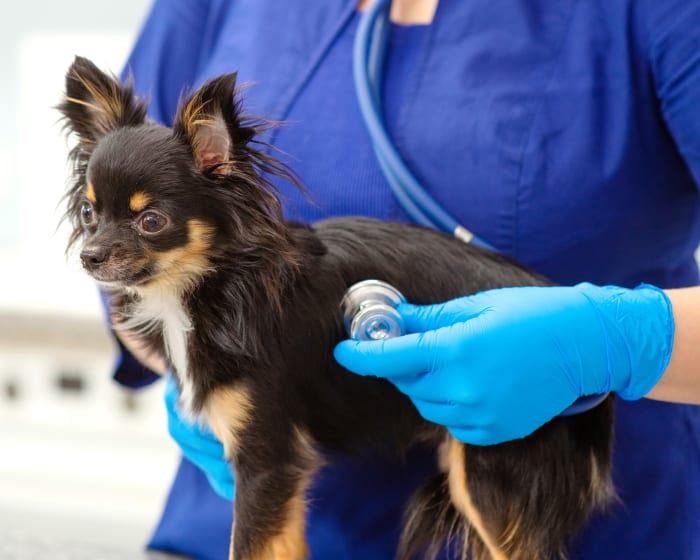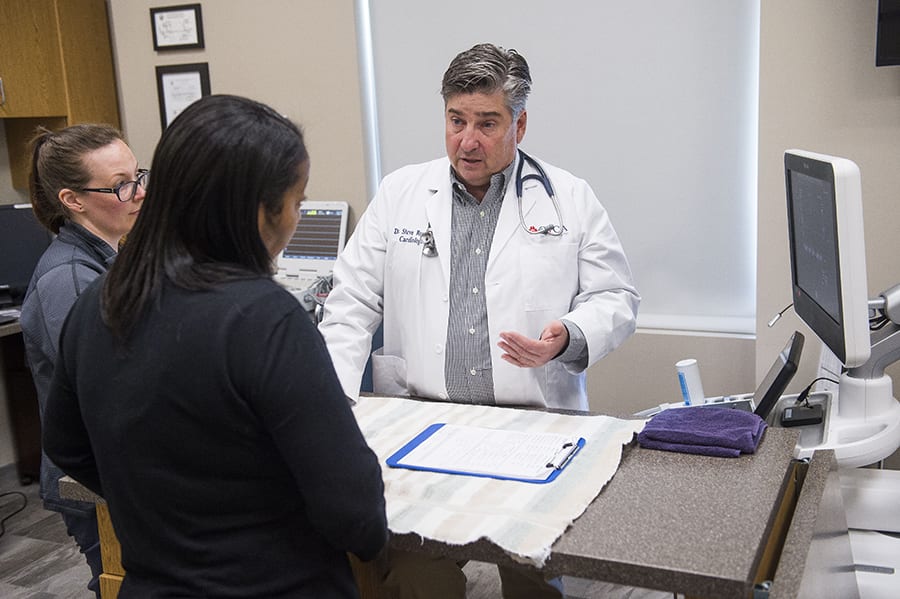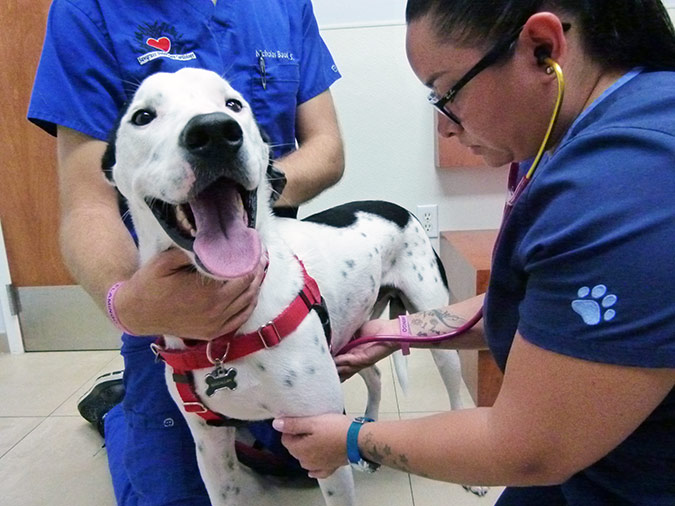Understanding the Full Scope of Care at a Cancer Veterinary Near Me}
Wiki Article
What You Required to Learn About Veterinary Solutions: An Introduction of Diagnostic Devices and Procedures
Veterinary solutions play a crucial function in keeping the health of pets. Routine examinations can reveal covert wellness worries at an early stage. Different analysis tools and treatments, such as blood examinations and imaging methods, give vital insights right into an animal's wellness. Recognizing these methods is vital for pet dog owners. What certain analysis procedures are most frequently used, and exactly how can they affect an animal's therapy strategy?Importance of Regular Veterinary Exams
While many animal proprietors might underestimate the importance of routine vet exams, these appointments are vital for keeping a pet's total wellness. Regular visits to the veterinarian enable early detection of prospective health and wellness concerns prior to they intensify right into severe troubles. Routine examinations usually consist of inoculations, which are very important for preventing contagious diseases that can seriously impact a family pet's wellness. In addition, these appointments give a possibility for vets to analyze the pet's weight, oral health and wellness, and general condition, ensuring that the pet is thriving. Throughout these sees, family pet owners can also receive beneficial recommendations on diet plan, exercise, and preventive treatment tailored to their particular pet's demands.Typical Diagnostic Treatments in Veterinary Medication
In vet medicine, exact diagnosis is vital for effective therapy. Typical analysis procedures consist of blood screening methods, progressed imaging modern technologies, and urinalysis, each playing a significant duty in recognizing health and wellness issues. Comprehending these approaches enhances the capacity to give appropriate look after animal individuals.Blood Evaluating Strategies
Blood testing strategies function as important analysis tools in vet medication, allowing vets to evaluate the wellness of animals precisely. These techniques include accumulating blood samples to examine various elements, such as white and red blood cells, platelets, and biochemical markers. Usual tests consist of complete blood matters (CBC), which evaluate general health and find infections, and biochemical panels, which evaluate body organ function and metabolic condition. Additionally, serological tests can identify certain conditions with antibody detection. Blood screening is minimally intrusive and provides vital details that aids in identifying conditions, monitoring health and wellness status, and assessing feedbacks to treatments. On the whole, these techniques play a crucial duty in guaranteeing optimal look after pet dogs and livestock alike.Imaging Technologies Used
Diagnostic imaging technologies are vital tools in veterinary medication, enhancing blood screening strategies by giving aesthetic understandings right into a pet's interior structures. Usual imaging techniques consist of X-rays, which work for evaluating bone fractures and identifying international things, and ultrasound, which permits for real-time visualization of soft cells and body organs. Magnetic resonance imaging (MRI) provides comprehensive pictures of complex anatomical areas, particularly in neurological assessments. Calculated tomography (CT) gives cross-sectional pictures, improving diagnostic precision for numerous problems. Each of these innovations aids vets in identifying health problems, preparing treatments, and monitoring recuperation. By integrating imaging innovations, veterinary specialists can better assess a pet's health and wellness and make notified choices concerning their care.
Urinalysis and Diagnostics
Urinalysis works as an important diagnostic tool in vet medicine, giving valuable understandings into a pet's general health and assisting in the detection of numerous conditions. This non-invasive treatment examines urine examples to assess kidney feature, hydration status, and metabolic problems. Common parts taken a look at include certain gravity, pH levels, sugar, proteins, and the existence of blood or bacteria. Irregular findings can suggest issues such as urinary system tract infections, diabetes mellitus, or kidney disease. To boost diagnostic accuracy, urinalysis is often done along with other examinations, such as blood job and imaging research studies. Early discovery through urinalysis can cause prompt interventions, enhancing the diagnosis for many veterinary individuals. For that reason, it is a crucial element of detailed veterinary care.Understanding Blood Tests and Research Laboratory Evaluation
Understanding blood tests and research laboratory analysis is important in vet medication as it assists in diagnosing different wellness problems in animals. Different kinds of blood tests give important info regarding a pet's interior state, while translating laboratory results needs cautious factor to consider of countless factors. This area will certainly explore the kinds of blood tests available and the significance of their results.Kinds Of Blood Tests
Blood examinations play an important role in veterinary medication, giving important insights into a pet's health status. Various kinds of blood tests are used, each offering various functions. Full blood counts (CBC) evaluate general wellness and detect problems such as anemia or infection. Biochemical profiles examine organ function by gauging electrolytes and enzymes, using insights into metabolic health and wellness. Serological tests determine specific antibodies or virus, helping in the diagnosis of infections or autoimmune illness. Blood keying guarantees safe transfusions, while coagulation examinations assess the blood's capacity to clot, important for operations. These tests jointly improve diagnosis, therapy preparation, and monitoring of an animal's wellness, highlighting the significance of comprehensive laboratory analysis in vet treatment.
Interpreting Lab Results
A detailed evaluation of laboratory outcomes is vital for accurate medical diagnosis and treatment in veterinary medication. Translating lab results needs an understanding of normal recommendation ranges and the relevance of deviations. Blood tests can disclose numerous health indications, such as organ function, electrolyte equilibrium, and the existence of infections. Veterinarians should take into consideration the whole medical photo, consisting of the pet's history, checkup searchings for, and any type of signs presented. Variants in results might develop from variables such as age, type, and underlying health and wellness problems. Subsequently, lab results must not be checked out in seclusion yet instead as part of a comprehensive analysis method. Exact analysis permits tailored therapy plans and much better results for veterinary patients.Imaging Techniques: X-rays, Ultrasounds, and Beyond
Imaging methods are vital tools in veterinary medicine, providing critical insights into the health and health of animals. Among one of the most typically used techniques are X-rays and ultrasounds. X-rays are invaluable for visualizing bone frameworks, helping veterinarians recognize cracks, lumps, or international items. This technique is non-invasive and fast, making it ideal for immediate situations.Ultrasounds, on the other hand, make use of audio waves to produce photos of soft cells and organs. This technique is especially useful for examining the heart, abdominal area, and reproductive organs, allowing vets to evaluate conditions like liquid accumulation or body organ abnormalities.Beyond X-rays and ultrasounds, advanced imaging methods such as computed tomography (CT) and magnetic resonance imaging (MRI) are increasingly used in vet technique. These techniques provide thorough cross-sectional photos, boosting the accuracy of medical diagnoses and therapy plans. Cancer Veterinary Near Me. On the whole, imaging methods play an important duty in guaranteeing reliable veterinary treatmentThe Duty of Biopsies in Diagnosing Animal Wellness Issues
Precision in identifying health and wellness problems in family pets frequently rests on making use of biopsies, which offer clear-cut information about cells problems. A biopsy entails the elimination of a tiny sample of cells for examination under a microscope, enabling vets to identify different problems, including infections, lumps, and inflammatory diseases. This analysis tool is essential for comparing malignant and benign developments, directing therapy decisions, and reviewing the severity of a condition.Biopsies can be done utilizing numerous methods, such as needle goal, incisional biopsies, or excisional biopsies, relying on the location and sort of cells involved. The option of method may influence healing time and the amount of cells gathered. Ultimately, the details amassed from a biopsy can result in targeted therapies, boosting outcomes for animals dealing with major wellness challenges. Vets stress the significance of this procedure in achieving precise diagnoses and reliable treatment plans.Advanced Diagnostic Equipment: Endoscopy and CT Scans

Advanced diagnostic tools, such as endoscopy and CT scans, play an essential duty in modern-day vet medicine, offering non-invasive methods to envision inner frameworks and identify different problems in family pets. Endoscopy involves using a flexible tube outfitted with an electronic camera, allowing vets to take a look at the stomach system and respiratory system directly. This method can expose irregularities such as tumors, foreign bodies, or swelling, enabling targeted treatment plans.CT scans, on the various other hand, make use of innovative imaging innovation to produce in-depth cross-sectional photos of the body (Cancer Veterinary Near Me). This technique is specifically helpful for reviewing facility structures like the brain, back, and joints. By giving high-resolution CT Scans For Dogs pictures, CT scans assist vets in identifying problems that may not be apparent through typical radiography. Together, these advanced devices boost diagnostic precision, boost treatment results, and ultimately add to far better overall animal health management

Analyzing Test Outcomes: What Family Pet Owners Should Know
Understanding test results can be a tough task for family pet proprietors, particularly after sophisticated procedures like endoscopy and CT scans have actually been performed. Analyzing these outcomes requires an understanding of medical terms and a clear understanding of what the findings indicate regarding the family pet's health. Veterinarians commonly supply descriptions, yet the intricacy of the outcomes can still cause confusion.Pet owners must actively participate in discussions with their veterinarians, asking concerns to make clear any kind of uncertainties. It is important to recognize normal versus irregular outcomes and the implications for the pet dog's treatment plan. Furthermore, recognizing that some results may call for additional testing or tracking can help owners remain notified about their pet's health journey. Ultimately, a collaborative strategy between family pet proprietors and veterinary specialists fosters better health and wellness results and boosts the general treatment experience for pets.Regularly Asked Questions
Exactly how Do I Pick the Right Vet Facility for My Pet?
Picking the best vet clinic involves researching local choices, reviewing credentials, going to centers, and assessing team communications (Ultrasound For Dogs). Focusing on suggestions from relied on sources can assist assure the very best care and setting for a family pet's health requirementsWhat Should I Do if My Pet Dog Refuses to head to the Vet?
When an animal refuses to head to the veterinarian, it's recommended to stay calm, usage treats or playthings to tempt them, and think about arranging a home browse through if anxiousness persists. Persistence and favorable support are crucial.Exist Telehealth Options for Vet Services?
Telehealth alternatives for veterinary services are increasingly available, permitting animal owners to seek advice from with veterinarians remotely. These solutions make it possible for discussions concerning health worries, advice on small disorders, and follow-ups without requiring to check out a clinic.
Exactly how Typically Should My Pet Have Oral Exams?
The frequency of oral exams for pet dogs generally relies on their age and breed. Typically, veterinarians suggest annual oral analyses, although some family pets might need more regular visits to preserve optimal oral health.
What Are the Costs Connected With Veterinary Diagnostics?
The expenses connected with veterinary diagnostics can vary commonly, generally varying from standard tests like blood work to advanced imaging strategies. Elements affecting expenditures include the clinic's place, devices made use of, and certain tests required for every pet. Vet services play a crucial function in maintaining the health of pets. While many family pet proprietors may ignore the importance of normal veterinary check-ups, these appointments are necessary for preserving a pet's total wellness. Furthermore, these consultations provide a chance for veterinarians to analyze the animal's weight, oral wellness, and general problem, making sure that the animal is flourishing. Precision in diagnosing health and wellness concerns in pets typically hinges on the usage of biopsies, which offer clear-cut information about tissue abnormalities. In addition, identifying that some results may require further testing or tracking can assist proprietors remain educated about their family pet's wellness trip.Report this wiki page